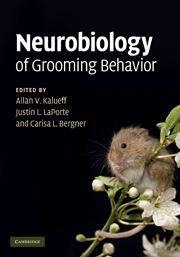Book contents
- Frontmatter
- Contents
- List of contributors
- Preface
- 1 Grooming, sequencing, and beyond: how it all began
- 2 Self-grooming as a form of olfactory communication in meadow voles and prairie voles (Microtus spp.)
- 3 Phenotyping and genetics of rodent grooming and barbering: utility for experimental neuroscience research
- 4 Social play, social grooming, and the regulation of social relationships
- 5 Grooming syntax as a sensitive measure of the effects of subchronic PCP treatment in rats
- 6 Modulatory effects of estrogens on grooming and related behaviors
- 7 Lack of barbering behavior in the phospholipase Cβ1 mutant mouse: a model animal for schizophrenia
- 8 Grooming after cerebellar, basal ganglia, and neocortical lesions
- 9 Striatal implementation of action sequences and more: grooming chains, inhibitory gating, and the relative reward effect
- 10 An ethological analysis of barbering behavior
- 11 Should there be a category: “grooming disorders?”
- 12 Neurobiology of trichotillomania
- Index
- References
11 - Should there be a category: “grooming disorders?”
Published online by Cambridge University Press: 04 August 2010
- Frontmatter
- Contents
- List of contributors
- Preface
- 1 Grooming, sequencing, and beyond: how it all began
- 2 Self-grooming as a form of olfactory communication in meadow voles and prairie voles (Microtus spp.)
- 3 Phenotyping and genetics of rodent grooming and barbering: utility for experimental neuroscience research
- 4 Social play, social grooming, and the regulation of social relationships
- 5 Grooming syntax as a sensitive measure of the effects of subchronic PCP treatment in rats
- 6 Modulatory effects of estrogens on grooming and related behaviors
- 7 Lack of barbering behavior in the phospholipase Cβ1 mutant mouse: a model animal for schizophrenia
- 8 Grooming after cerebellar, basal ganglia, and neocortical lesions
- 9 Striatal implementation of action sequences and more: grooming chains, inhibitory gating, and the relative reward effect
- 10 An ethological analysis of barbering behavior
- 11 Should there be a category: “grooming disorders?”
- 12 Neurobiology of trichotillomania
- Index
- References
Summary
Summary
Grooming disorders, such as trichotillomania (TTM), nail biting, and skin picking, are receiving increasing attention from researchers and clinicians. This is in part due to their possible link to obsessive–compulsive disorder (OCD). It is imperative that these disorders are categorized correctly in order to facilitate research and aid diagnosis and treatment. However, within current psychiatric classification systems TTM is currently conceptualized as an impulse control disorder and nail biting, lip biting, and skin picking are not yet included in the official nomenclature. It is therefore unclear whether these grooming disorders should form a category on their own (i.e., “grooming disorders” or “pathological grooming behaviors”), or whether they should be classified as obsessive–compulsive spectrum disorders (OCSD), impulse control disorders, or as body-focused repetitive behaviors. This chapter will discuss these diagnostic and taxonomic issues particularly as they pertain to clinical practice, fostering further discussion on the psychopathology of aberrant grooming behaviors.
Introduction
The positioning of TTM and other conditions characterized by self-directed repetitive behaviors (e.g., nail biting and pathological skin picking [PSP]) within existing psychiatric classification systems has recently been debated (e.g., Stein et al. 2007). Trichotillomania is classified in the most recent edition of the Diagnostic and Statistical Manual of Mental Disorders (DSM-IV-TR; APA, 2000) as an impulse control disorder. However, some researchers suggest that TTM is an OCSD (Swedo and Leonard 1992).
- Type
- Chapter
- Information
- Neurobiology of Grooming Behavior , pp. 226 - 251Publisher: Cambridge University PressPrint publication year: 2010
References
- 1
- Cited by



